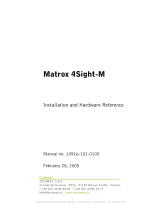
14 Matrox QID Series – User Guide
3 Connect video output
To connect to a TV or a video recorder, you’ll
need a composite video (RCA) or S-video
cable.
If your video device (a TV or a video
recorder) didn’t come with one of these
cables, these types of cable are available at
most electronics stores. The type of cable
you use depends on what your video device
supports. Many video devices support
composite video connections, and some
higher-quality video devices support
S-video connections.
For each TV or video recorder, you want to
connect to your Matrox product:
a
Attach one end of your composite video
or S-video cable to the appropriate
connector on your TV-output cable.
b
Attach the other end to the
VIDEO IN
*
connector on your TV
†
or video
recorder.
c
Before viewing or recording video output directly from your computer, make sure your
TV or video recorder is set up to use
line
input. For example, if your TV has a
TV/VIDEO
switch, set it to
VIDEO
; or if your video recorder has a
TUNER/LINE
switch, set it to
LINE
.
Optionally, if you use the composite video
and
S-video connectors on your TV-output cable,
you can directly connect two different video devices at the same time.
To view
and
record output from the same Matrox video connector, you can connect it to a
video recorder and connect the video recorder to a TV. For more information, see your video
recorder and TV manuals.
* The labels on your devices may not be consistent with what’s in this guide. Different manufacturers sometimes use different labels
for the same type of controls and connectors. For example, the
VIDEO IN
connector on your TV may be labeled
VIDEO 1
(or
VIDEO
2
). To match labels, see the documentation for your video devices.
† If your TV only has an antenna or cable TV connector, you can use an
RF modulator
to connect it to your Matrox card. RF
modulators are available at most electronics stores.
TV or video
recorder using
S-video
Composite
video (RCA)
cable
S-video
cable
TV or video recorder
using composite video
Dual-TV-
output cable
(Note: Using the Matrox composite
video and S-video connectors at the
same time is optional.)























